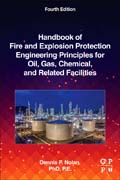
Handbook of Fire and Explosion Protection Engineering Principles for the Oil, Gas, Chemical, and Related Facilities
Nolan, Dennis P.
There are extensive resources full of fire and safety codes and standards, but they are not written specifically to oil and gas or other related process engineering industries, and most engineers must search in multiple locations to locate all the relevant pieces, costing time and money. Handbook of Fire and Explosion Protection Engineering Principles for the Oil, Gas, Chemical, and Related Facilities, Fourth Edition starts off with high-level risk analysis and progresses to cover advanced technical considerations such as process control, emergency shut-downs, and evaluation procedures. More engineers and managers are adopting risk-based approaches to minimize risk, maximize profits and keep operations running smoothly, and this reference encompasses all the critical equipment and standards necessary for the process industries, including oil and gas. Updated with new information covering fire and explosion resistant systems, drainage systems, and human factors, Handbook of Fire and Explosion Protection Engineering Principles for the Oil, Gas, Chemical, and Related Facilities, Fourth Edition continues to deliver all the collective design and equipment standards needed to protect today's petrochemical assets and facilities. Revise and upgrade company policies to support safer designs and equipmentUnderstand the latest in fire suppression and explosion risks for a process plant in one convenient sourceGet updated from a completely revised chapter on evaluating concerns, helping engineers and managers process operating requests and estimate practical cost benefit factors INDICE: 1. Historical Background, Legal Influences, Management Responsibility, and Safety Culture2. Overview of Oil, Gas, and Petrochemical Facilities3. Philosophy of Protection Principles4. Physical Properties of Hydrocarbons and Petrochemicals5. Characteristics of Hazardous Material Releases, Fires, and Explosions6. Historical Survey of Major Fires and Explosions in the Process Industries7. Risk Analysis8. Segregation, Separation, and Arrangement9. Grading, Containment, and Drainage Systems10. Process Controls11. Emergency Shutdown12. Depressurization, Blowdown, and Venting13. Overpressure and Thermal Relief14. Control of Ignition Sources15. Elimination of Process Releases16. Fire and Explosion Resistant Systems17. Fire and Gas Detection and Alarm Systems18. Evacuation Alerting and Arrangements19. Methods of Fire Suppression20. Special Locations, Facilities, and Equipment21. Human Factors and Ergonomic Considerations22. Evaluating ConcernsAppendix A Testing Firewater SystemsAppendix A-1 Testing of Firewater Pumping SystemsAppendix A-2 Testing of Firewater Distribution SystemsAppendix A-3 Testing of Sprinkler and Deluge SystemsAppendix A-4 Testing of Foam Fire Suppression SystemsAppendix A-5 Testing of Firewater Hose Reels and MonitorsAppendix A-6 Fire Protection Hydrostatic Testing RequirementsAppendix A-7 Process Hazards Review QuestionsAppendix B Reference DataAppendix B-1 Fire Resistance Testing StandardsAppendix B-2 Explosion and Fire Resistance RatingsAppendix B-3 National Electrical Manufacturers Association (NEMA) ClassificationsAppendix B-4 Hydraulic DataAppendix B-5. Selected Conversion Factors
- ISBN: 978-0-12-816002-2
- Editorial: Gulf Professional Publishing
- Encuadernacion: Rústica
- Páginas: 550
- Fecha Publicación: 01/11/2018
- Nº Volúmenes: 1
- Idioma: Inglés
